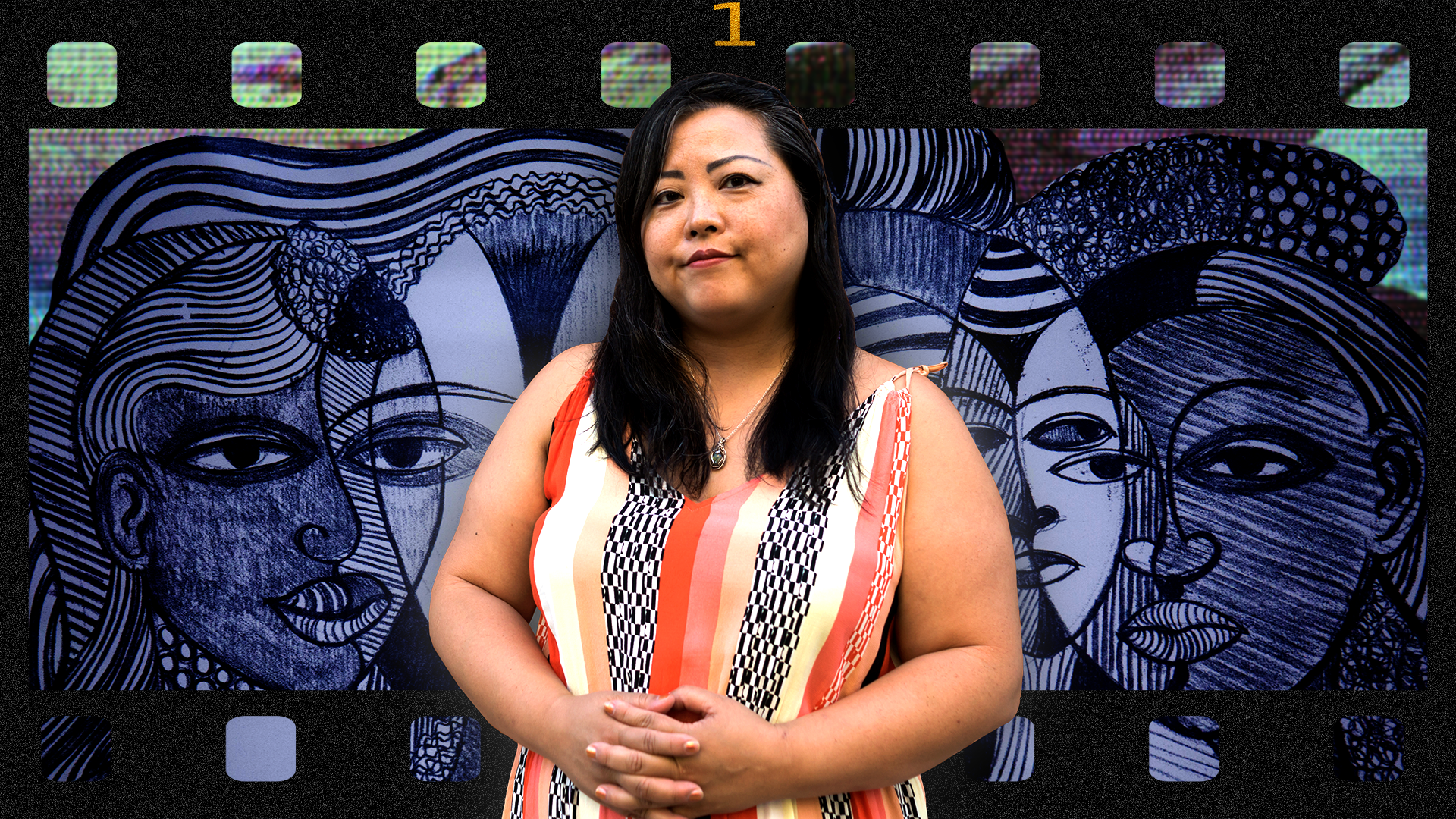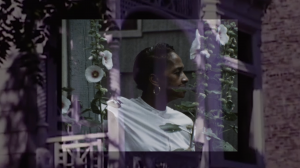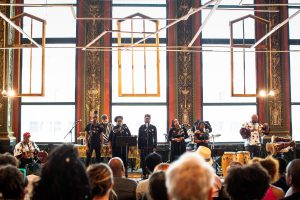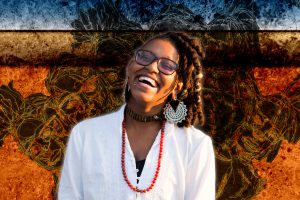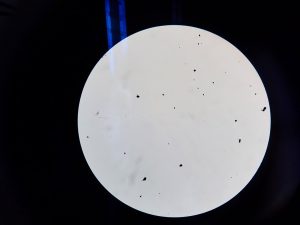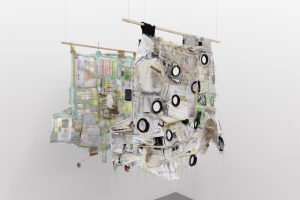Sarah-Ji (she/her) is a movement photographer and abolitionist who documents freedom struggles in Chicago. She is also an active member of For the People Artists Collective, a squad of Black and artists of color who also organize and create work that “uplifts and projects struggle, resistance, liberation, and survival within and for marginalized communities and movements.” For nearly a decade she has created a visual archive of liberation struggles for Black, Brown, Indigenous, queer, trans, and intersex lives. She documents and sheds light on the everyday people of Chicago who show up and actively resist systemic, hyper-local and social oppression. Thus, her camera becomes a tool of liberation and a pathway toward envisioning a world without police and prisons, where struggle does not take precedence over love, justice, and community. Her photography illustrates the power of sustaining strong relationships as organizing artists while committing to the heavy lift of resistance and social activism.
This interview was shortened for length and clarity.
Ireashia: Tell me a little about how you came to photography and what drew you to it.
Sarah-Ji: My dad was a news reporter when we lived in Korea, and so as part of his job he kind of became an amateur photographer. So we always had a camera. When we were moving from Seoul to Chicago, my dad bought an old Canon pocket camera that took 110 film. It was a rangefinder camera, really small. He bought it at a Duty-Free shop in Tokyo when we had a layover. That was the camera I started playing around with when I was a teenager, which was when I first started doing photography. I’m pretty much self-taught, so I learned by fiddling around. When I graduated from grad school, as a graduation present I bought myself a 35mm Nikon SLR. So that’s how I started doing photography. Basically started taking my camera with me everywhere, and kind of became the designated photographer, wherever I happened to be.
Ireashia: How does it nourish you, creatively? Do you ever feel bored by it, or are you always finding new ways or new things to discover with photography?
Sarah-Ji: I feel like photography was the first thing that I picked up where I felt like I could create something visually that I felt good about. And also, the thing that I love so much about photography is the way it enables me to preserve memories. And for me, memories are such a huge thing because moving to the U.S., my immigration was such a huge disruption, for me personally. I was six years old when we left. And I remember as a child just being afraid of losing my memories of Korea. Especially because there was also the language change as well. When I first came to the U.S., the policy back then in the schools was to encourage parents to speak only English in the home so we would pick English up faster…which is a really horrible policy, because then it discourages bilingualism or multilingualism. Actually, knowing more than one language is really beneficial for the way the brain works. So, unfortunately, my brother and I both lost our Korean when we were really young because what my school principal told my parents to do. So there’s always this angst of losing memories that are also tied to language. Photography became a kind of tool for me, so that going forward I can preserve my memories. This is a tool for me to preserve my memories.
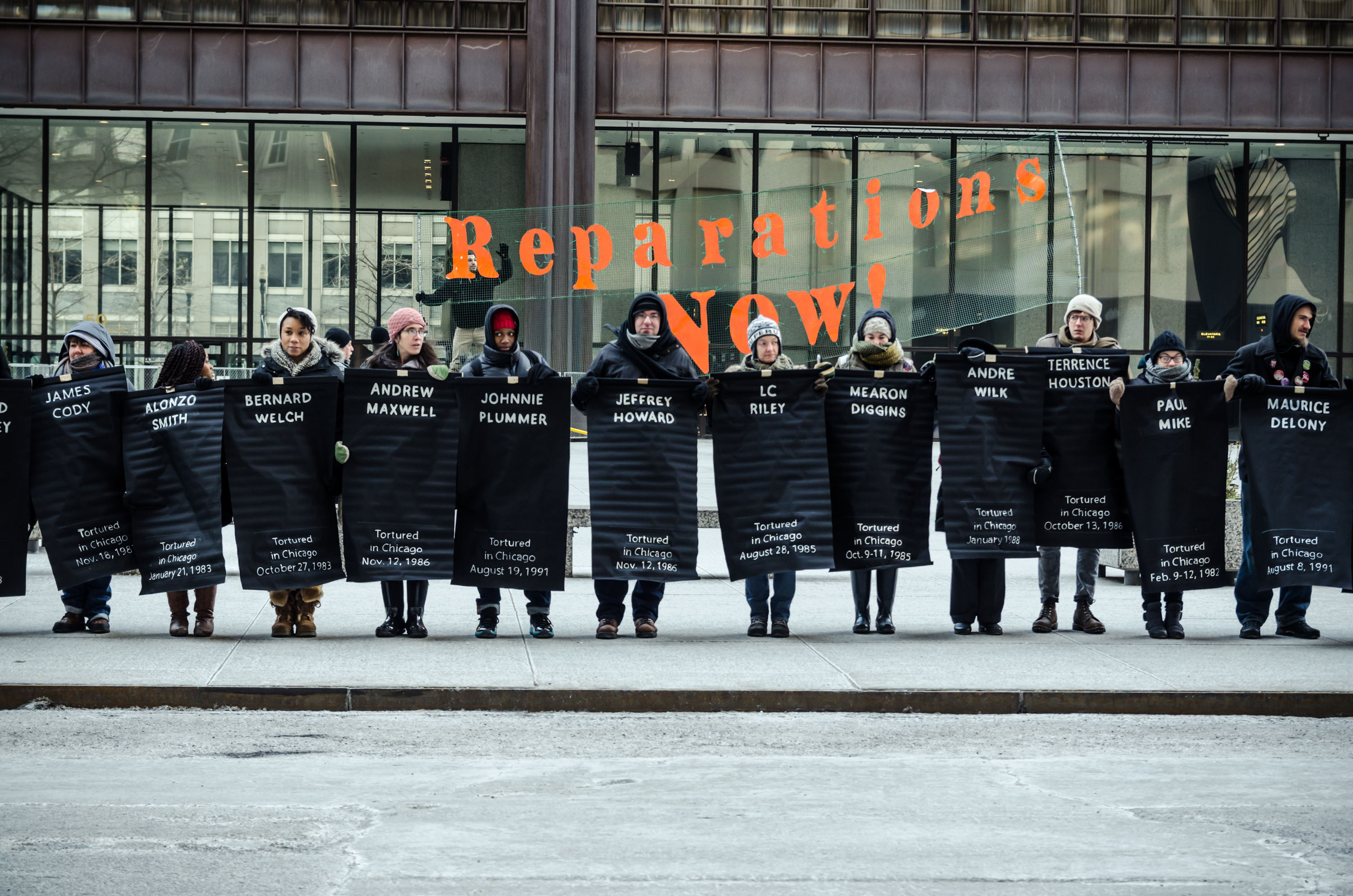
Ireashia: Yeah, that’s how I feel about it too. When I came to photography, it was a means to validate that I existed, and to validate bodies like mine, skin like mine, people like me exist in this world. And kind of like what you said about preserving – I was here at this time, on this day – tracking growth, in a way. I find that so significant and valuable about photography. Do you consider yourself an activist or a movement artist? How would you identify yourself?
Sarah-Ji: I do identify as a movement photographer because my work does primarily focus on social movements here in Chicago. That’s not how I started in photography, though. I kind of started getting more serious about my photography after I had my daughter 14 years ago. And so she became my model in terms of someone always around for me to take photos of – so she probably has one of the best-documented baby-hoods, or toddler-hoods, of any child. It also was a way for me to preserve memories that I had with her, because…you think that you’ll remember everything, especially when it’s your child – but you don’t. I was a mommy-blogger, basically. I had a photo blog where I would write about being a mom, I would post photos. And when she was around six, that’s when I first became politicized. Before then I wasn’t really political, and I happened to find out about a protest happening in Pilsen. It was an occupation of a field house at a school there, at Whittier Dual Language Academy. And the moms found out that CPS was about to demolish their field house, which they had been using as a community center for years. And so, they took over the field house.
Ireashia: I think I remember that…
Sarah-Ji: It was exactly 8 years ago, literally to the day, that it started. And I remember finding out about it on Facebook randomly, and I’m just like oh my gosh. When I heard that the police had surrounded it and they weren’t letting people allow food or water in I was like this is fucked up, what should I do. So I just randomly showed up with my camera. I’m this mom from the North side – no connection to the community, nothing at all, I have no idea about organizing, I just showed up with a camera. I was lucky the organizers didn’t just kick me out. And that was kind of where I got my baptism by fire and an introduction to organizing. That was the first struggle that I documented in Chicago. After that, I did a lot of education justice-related work, and that eventually led to meeting Mariame Kaba. It was through meeting Mariame and her mentorship that I was introduced to work that was being led by, mostly by young Black people in Chicago, which would eventually lead to the workaround and against police violence – what is essentially abolitionist work. Part of being a photographer, I see that as a tool in my organizing. Because, literally, it’s the one thing I know how to do and that I feel comfortable with, and the most at home in terms of how confident I feel doing it.

Ireashia: We all have a role, you know? And I think that, even intuitively, you just kind of took to this role, right? You could’ve just scrolled past that story, that event, like whatever. But you said no, this needs to be documented. And that’s so important, especially for organizers and activists that may not always have money to pay to document these actions or document these events. The fact that you just took ownership of that role is so important. I remember seeing your work around 2015, mostly when We Charge Genocide became really known – and I was like wow, who is this person!? Obviously, you like your activism to intersect with your artistry. Can you tell me more about how you balance your activism and your art – or are they kind of the same thing to you?
Sarah-Ji: Right now, at this point, they’re very much intertwined, because my primary work is documenting freedom struggles in Chicago. It’s taken away time from the other photography I used to do. I used to do a lot of street photography, or even just documenting [my daughter] Cadence’s life. I don’t do as much of that as I used to, and part of that is because so much of my photography energy is put into documenting the movement. And sometimes I’ll be just spent, and those are the times I just don’t want to have a camera. But what I feel is really important, I chose the name, the moniker Love and Struggle Photos, because I feel that those two are so intertwined in the work that I document. Because what I’ve learned from the organizing work here in Chicago is that love is so foundational. People are fighting for their lives, people are fighting for their children’s lives, and their parents’ lives, their grandparents lives…and love is so essential to that. So when I do document protests or any campaign, it’s really important for me to find those moments of love, where it captures that emotion that is interpreted or that is practiced as struggle. And that translates to how I document my own everyday life. It’s still important for me to document the people I love because this is the community that surrounds me and holds me and they’re the ones that make it possible for me to do the work that I do, I couldn’t do it without them. And it’s a reminder to me as to why I do this work as well, because my community are also organizers and they’re part of the same struggle here in Chicago.
Ireashia: What do you think the role is for photographers – in your opinion – who want to get involved in the movement or want to just do work?
Sarah-Ji: For me, I see the role as capturing people’s stories – but not in a photojournalist kind of way. It’s really important for me to have relationships with the people that I’m documenting, because I want to know what their story is that they want told. Especially when there are specific struggles, there’s a specific narrative. In any type of media strategy there are certain things that the people who are organizing will want to be told as part of the story. That’s important for me to know as a photographer who is in solidarity with people, that I’m not just going in without any knowledge about a campaign and just taking pictures…I don’t think that is effective. It’s important for photographers who want to be movement photographers to be in relationships with the communities they’re documenting. You have to be on their side. You have to be in the struggle with them. Telling the right narrative is an important role for photographers, and as much as possible, allowing people to tell their own stories. I don’t want to be the voice for people, I don’t want to be the eyes for people. Especially if the struggle doesn’t impact me personally, I can’t know what the whole story is, so that’s where the relationship building is really important.
Ireashia: I think about my origins as a journalist, and how after I graduated I was like, this is a lot of power, and I don’t feel comfortable with that. I think journalists, and people who call themselves storytellers, and who work specifically in marginalized communities – that power differential is really imbalanced. What is a more ethical way to go about it? What is a more mindful and intentional way of being an outsider, being someone who isn’t local to Chicago, but also having something personal at stake, having a connection to the struggle in some way…just, being more mindful, you know?
Sarah-Ji: Yeah, it’s really important to have accountability. That’s really important to me. When I document things for specific organizations, the ones that I’ve had long-term relationships with, they know they can always come to me. Especially if they have a certain visual that they’re trying to capture in a specific protest or action…they know that they can communicate that to me so that that’s what I’ll capture. There’s also dangers involved in photographing protests, because you can document something that’s an arrestable action, and you don’t want to endanger people. So being aware of what I put out there on the internet. Like if certain people have certain vulnerabilities where they can’t allow certain images to be shown, then I’m not going to put that out there.
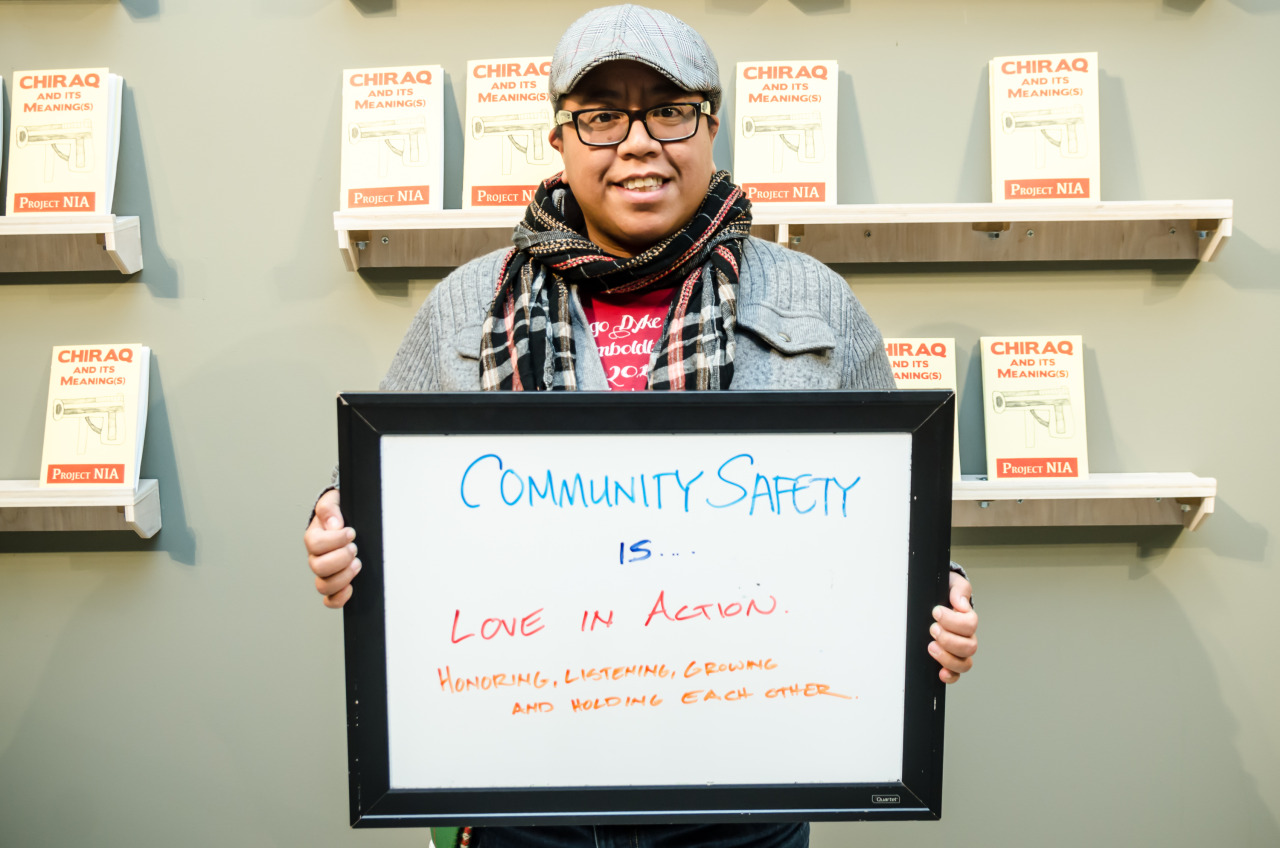
Ireashia: I think that in this time where it feels like to show that you’re producing work – like quantity is always over quality these days. How do you deal with social media bullshit? When I say that I mean producing work that isn’t always timely but producing work that’s for you.
Sarah-Ji: I think the nature of the work with movement photography when things happen fast, it is important to get things out within a certain time-frame, because that’ll be needed by the organizations that are doing the work. It is stressful, and it does keep me from being able to do more long-term projects. I’ve only had a few. But the ones that I’ve done have been really meaningful for me.
I had a project with Mariame Kaba called “Community Safety Looks Like”, and it was a whiteboard project where we asked people to envision what would community safety look like to you? And they would write their answers, and we collected these photos and Mariame had a Tumblr of them. We put out a book of some of the photos from that. It’s an ongoing project. People have kind of taken that and done other things with it. You’ll see a lot of whiteboard photo projects – and for me, that specific project was really meaningful because it was part of having the community reimagine what safety looks like, which to me is a huge part of abolition. Photography, for me, is a tool towards abolition. For me, my end game is abolition. The thing that I know how to do is photography. So I’m going to use photography in whatever ways will contribute to creating the conditions that we’re going to need for abolition to really be possible.
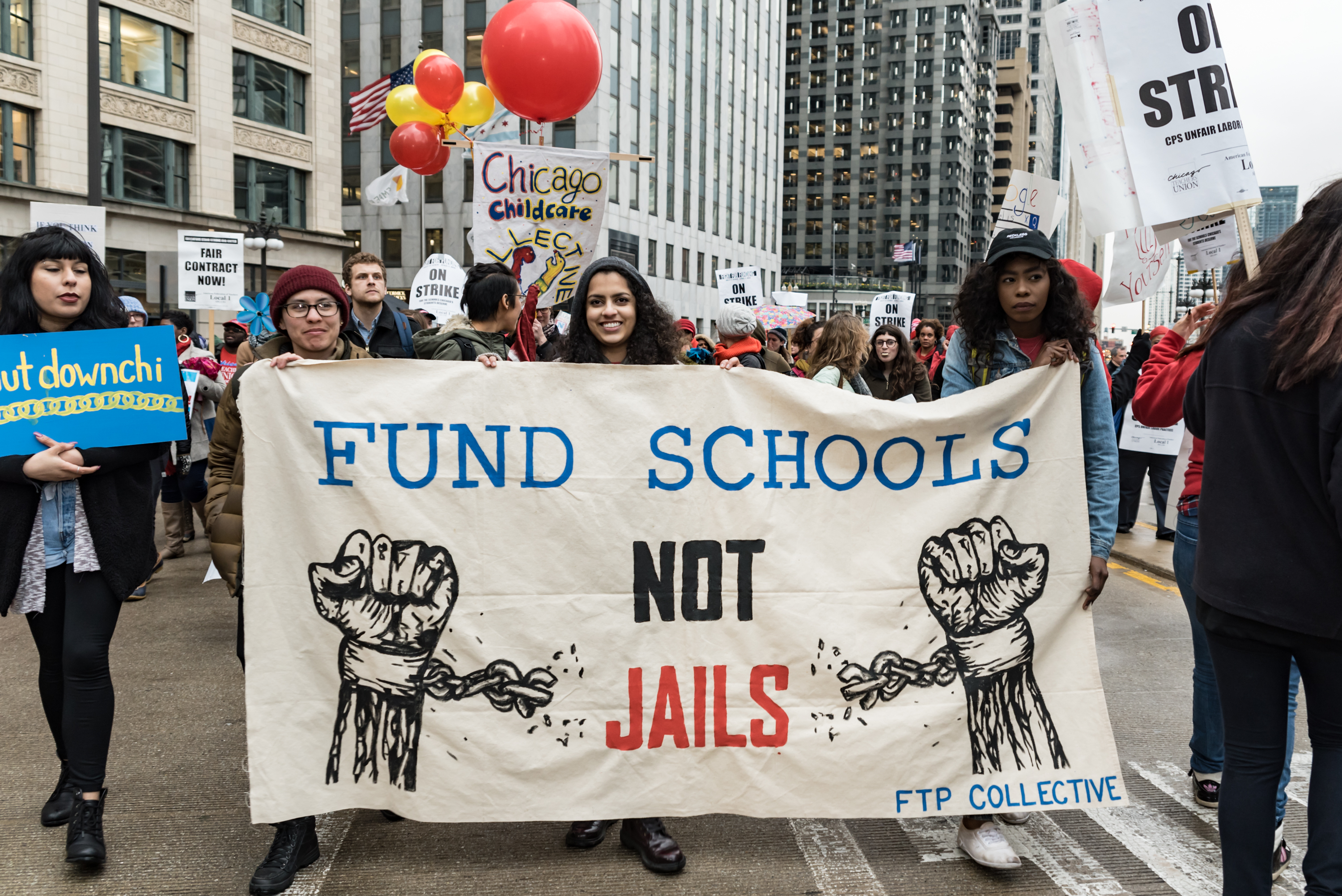
Ireashia: I’ve been following the work of For the People Artists Collective for about a year. And I’m just really – not just impressed, but really inspired by how dope everyone seems to just love on each other, how genuine the love and the respect for one another as artists, as people, just seems to emanate from FTP. Can you share a little bit about how FTP started, and your involvement in it, and how has being a part of a collective like that uplifted and supported you?
Sarah-Ji: Yeah! So, FTP was co-founded by Monica Trinidad who’s been doing movement art not just in Chicago, but also nationally for national campaigns for a few years now. It started the winter of 2016, that January we first came together as a group. Monica is my best friend, she’s one of 3 best friends I have. When she started FTP I was like, okay, whatever, I wasn’t thinking about being a part of it, but Monica has been one of the few people who’s been challenging me to accept my identity as an artist. It was so hard for me to own that, and I think that’s true for a lot of people who are in FTP, because most of the people are self-taught. And so, for those of us who haven’t had a lot of formal training as artists, just claiming that identity of an artist is a huge deal, and to be able to support each other in that. The other thing about FTP is that we don’t identify solely as artists, we also identify as organizers. That’s an important part of being a part of FTP is that it has to be connected to the work that’s going on, the art that we create. For the People was inspired by something that Emory Douglas had actually said about how artists can’t just be in these ivory towers making their art, they have to be amongst the people and they have to make art amongst the people. There is a lot of history behind movement art, and I think in Chicago there is a really rich legacy of protest art and movement art. Some of that has really been within the academics sphere. When I first started organizing, the artists that I knew who were doing the work were mostly academics. It was really after We Charge Genocide that art-making became an important part of the protests that we were a part of, whether it was making banners or making puppets – any kind of visuals that were created, and it was coming from everyday people. So yeah, For the People Chi has been supporting a lot of the campaigns I’ve been going on – the first one they were really involved in was the Bye Anita campaign. It laid a good foundation because we took our cues from the organizers, and the organizers were primarily Black, queer, women and femmes in Chicago. And, from the beginning, that’s who we really kind of tried to center in the work that we do. We’re all people of color, first of all, as an organization, and most of us are queer. I think that impacts whose leadership we want to follow in terms of the organizing we want to do. The Bye Anita campaign was just thrilling, you know? Something was happening every day, and just to see that campaign be successful was really great for FTP to be a part of that.
Ireashia: Are you working on any projects or anything right now? If you want to share.
Sarah-Ji: I’ve been thinking a lot about my roots, you know? I’ve had a lot of family members pass away this year, and also just with things happening politically in Korea, on the Korean peninsula. Because I have roots in both North and South Korea, so I’ve been thinking a lot about my family history and grappling with the disconnection that I’ve felt just because I was raised so far away from my roots. Something that I would really like to do in the future is to go back to Korea and visit the places that have been important to my family history and do a place-based photo project. I don’t know how that would work…
Ireashia: You could get a Propeller Grant!
Sarah-Ji: [laughs] Yeah…but just in terms of exploring my identity of who I am, where do I come from…It’s so important to me to have those answers, to have those questions answered. And I’ve been in therapy this past year, and that’s one of the things I’ve been exploring with my therapist is where do I come from, and how have my experiences from childhood impacted who I am today. I’m trying to find what puzzle pieces I have to fit together to figure out my own healing, you know? And I feel like a lot of that has to do with feeling like I don’t have a place to belong. I just think specifically with my identity as a Korean woman; a lot of Koreans fled the city 20 years ago, most of them moved to the suburbs. So I don’t even get to see a lot of Korean people in the city anymore, and just a hunger for being with my people. But at the same time, knowing that a lot of that comes with discomfort because of the political differences I have with most of the Koreans that I know. The Koreans I grew up with were all raised in Evangelical Korean Churches and that came with its own baggage of politics. When I go visit my family and I try to talk to them about things like police violence, even just the harm Koreans have done to Black communities – that’s a really difficult topic for my family members to even listen to. But at the same time, I have this yearning to fully understand what it means to be Korean and to know where it is that I come from. If I could do a photo project to figure that out, that’d be great.
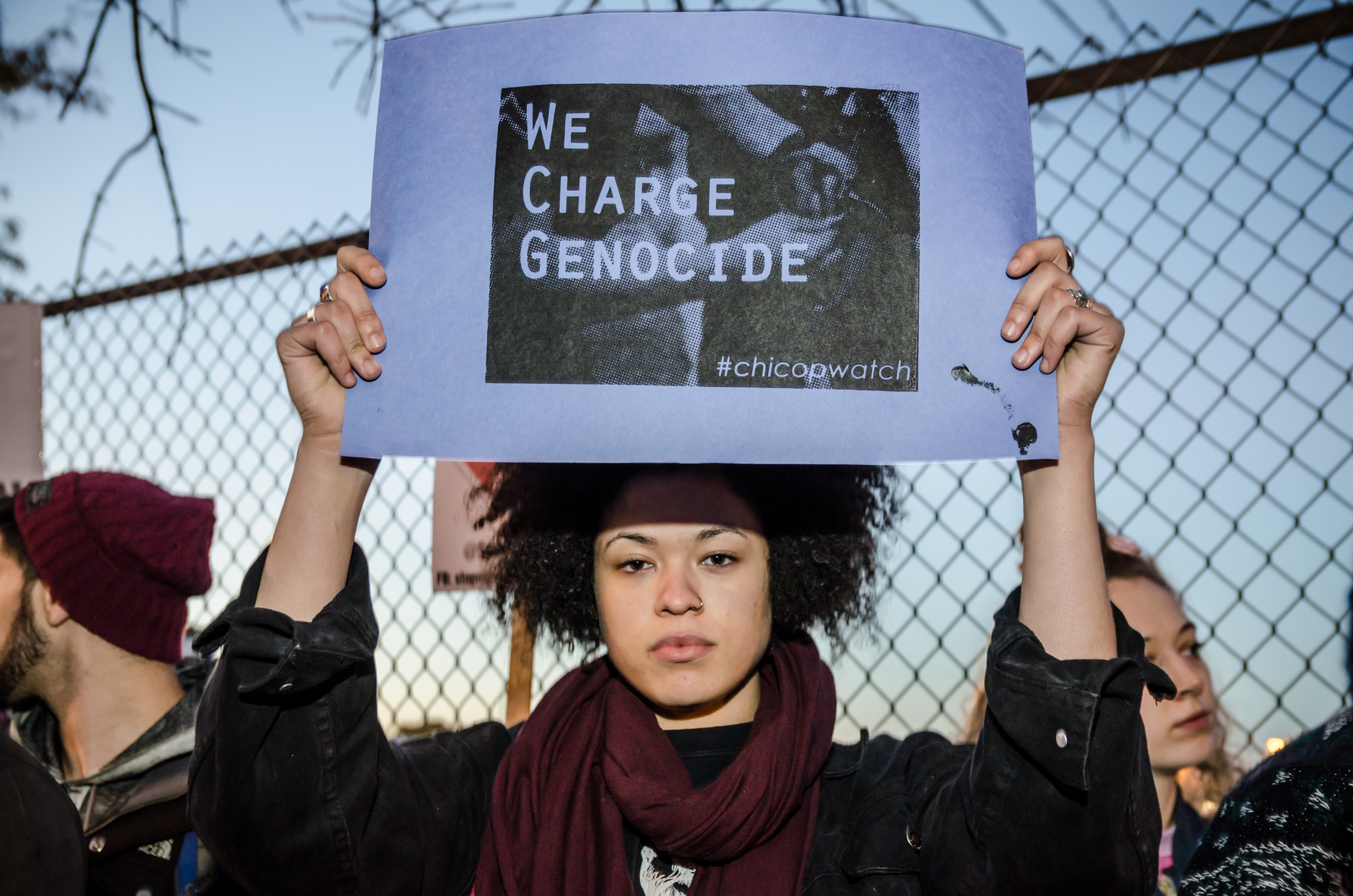
Ireashia: That would be really brilliant…I can already see it! I feel like for some reason there’s something in the air about feeling rooted somewhere, which comes from displacement and familial displacement. For me, it was really important for me to know where I came from first, so that I can feel secure within myself enough to enter different communities and not appropriate or not identify too much to the point where I’m blurring boundaries with my own identity. I totally see why it’s so important to you and why there’s a yearning. Plus, you can give that to your daughter, to your family, your chosen family, as a gift, I imagine. You said your work is very taxing emotionally, physically – how do you kind of balance being out in these streets, and just taking care of yourself first?
Sarah-Ji: Well, I mean honestly I don’t do a very good job of that…my therapist has been trying to help me with that. She’s really good at reminding me about taking care of all parts of myself. But Cadence, my daughter, is really good about forcing me to not do as much as I would. If it weren’t for Cadence, I would probably do twice as much as I do, and she reminds me of the importance of caring for her, you know? I don’t think she really thinks about me, but you know she reminds me it’s important to her that I make the time for her needs. When she was little, she would just follow me to protests, but she’s at the age where she does her own thing, so I can’t just like take her with me everywhere anymore. Also, the people I’m in a community with – my chosen family, my friends, people who are closest to me – they’ll help me to recognize when I’m just doing too much and when I should just take a step back. In the past year, I’ve felt a little bit more comfortable with not having to be everywhere. Especially because I have a full-time job, and I think a lot of people don’t realize I have a full-time job, but I’ve also just been physically feeling the results of doing this work for 8 years, in terms of documenting movements on a regular basis here in Chicago. I’m tired a lot. My body just feels worn out. So out of physical necessity, I’ve been taking more time to myself. But honestly, I feel like happiest when I’m doing the work. That’s when I feel most energized. But I also have been recognizing my physical limitations because I have chronic pain, and I suffer from migraines… there are other things that force me to slow down. But I’m still learning to accept that as a good thing, the slowing down part.
Ireashia: It can be kind of hard, because I feel like you have been so visible, and your work has exonerated and uplifted and that feels really heavy, I can imagine. I’m glad that you’re figuring out your balance, your flow, because that’s important.
Sarah-Ji: And I’m really hoping that – I would like to see other photographers, especially young photographers, doing that work as well, and I would love to support them doing that work.
Ireashia: Like a mentor?
Sarah-Ji: Yeah, and just having somebody else show up would be great! [laughs]
Ireashia: [laughs] That’s real. How do you envision your impact as a movement photographer in terms of Chicago’s activist history?
Sarah-Ji: One of the reasons I do the work that I do and I put so much of myself into this work is because I think that a visual history of resistance is really important for the people who are in the struggle now to be able to see visually how their struggle is being played out and is being created, as well as for future generations. I know that when I look at photos from past resistance – the Civil Rights Movement, and even beyond – it has an impact. There’s something about photos that I think people can relate to on a really visceral level. And I’m kind of a completist, you know, so for me being consistent is really important. And I hope that’s what I can give back to Chicago, is a consistent history of resistance over a long period of time. Because what I know for sure is that resistance is always happening and has been happening for decades in this city. I would feel really good about my work if that’s what I can leave behind. And at the same time, photography for me is a tool for something that’s greater. For me, it always goes back to abolition. And I feel like so much of the work that is being done in Chicago is abolitionist in nature, even if the people may not see it that way or may not identify as abolitionists. When you’re creating conditions so that people’s needs are met? That’s abolitionist. Anything that will make police and prisons less necessary, to me, that’s abolitionist. I always say that my primary motivation in life is not so much the photography that I do, but it’s this vision for abolition. I use photography as a tool to also help other people to envision that future by seeing the resistance that’s happening now to create that future. Even just those whiteboard projects – seeing how other people view community safety can plant seeds in people’s imaginations, and that’s what I hope for.
Ireashia: I think you’re doing a great job. 8 years is pretty consistent.
Sarah-Ji: Thanks!
Ireashia: Those are all the questions that I have, do you have anything you would like to add or you would like to specifically talk to or speak to?
Sarah-Ji: All I would want to say is I’m so grateful to the people in Chicago, to the communities who have been resisting for so long, because I’ve learned so much from them. For me, I consider it a real honor to be able to document that resistance and those struggles and I have so much love for the people, and I see so much love, and they’ve given me so much love, as well. And I really appreciate that.
Ireashia: That emanates through all of your work.
Sarah-Ji: Thank you.
This article is published as part of Envisioning Justice, a 19-month initiative presented by Illinois Humanities that looks into how Chicagoans and Chicago artists respond to the impact of incarceration in local communities and how the arts and humanities are used to devise strategies for lessening this impact.
Featured Image: Portrait collage. Sarah-Ji looks directly at the camera with a slight smile on her face. She is wearing a white, salmon, orange, and patterned colored dress with her hands interlocked in front of her. In the background is a television glitch graphic with the painting titled “Faces (Faces a la Picasso)” created by the artist, scholar and activist Margaret T. Burroughs. The image is framed by a 35mm film strip. Photo and collage were created by Ireashia Bennett. All other images were sourced online.
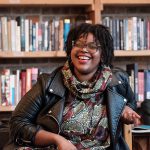
Ireashia Monét (they/them) is a Chicago-based self-taught photographer, filmmaker, writer, and multimedia artist originally from PG County, MD.
